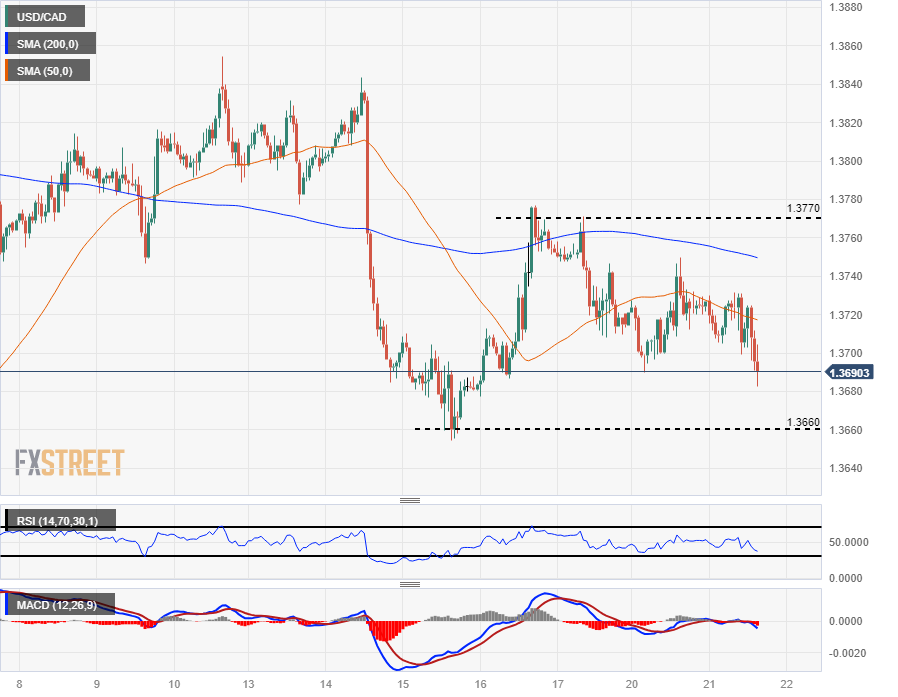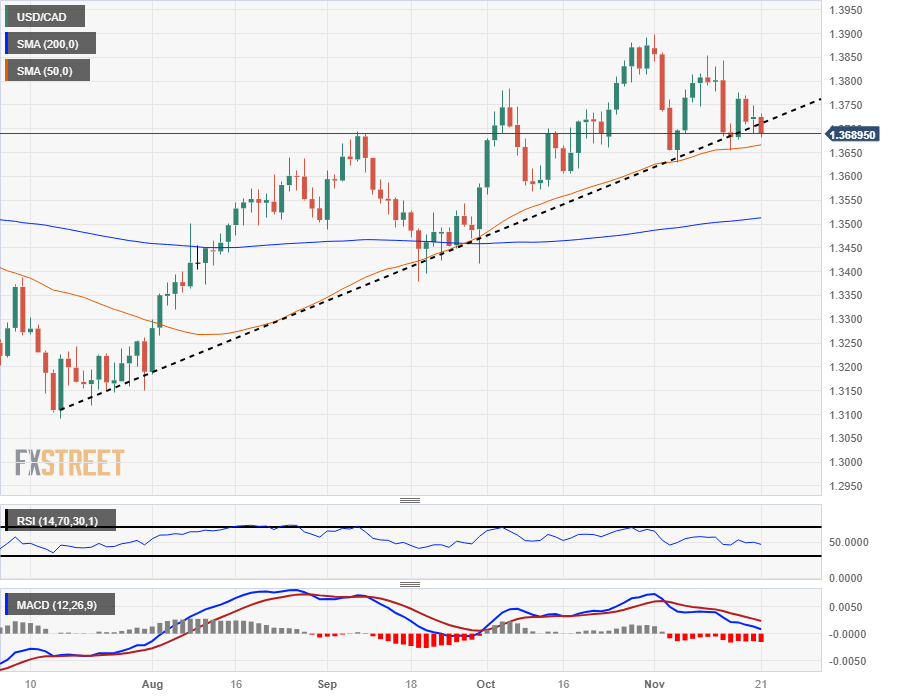- Analytics
- News and Tools
- Market News
- Canadian Dollar looks for headroom, finds limited upside after Canada CPI misses the mark
Canadian Dollar looks for headroom, finds limited upside after Canada CPI misses the mark
- The Canadian Dollar is seeing higher bids on Tuesday, but momentum remains thin.
- Fed’s latest Meeting Minutes are due in the early afternoon.
- Crude Oil is grinding sideways above $77.00, limiting CAD support.
The Canadian Dollar (CAD) is looking for further upside against the US Dollar (USD). Loonie momentum remains limited with Crude Oil spinning in place and investors focusing on the Federal Reserve’s (Fed) latest Meeting Minutes due at the top of the US market session.
Canadian Consumer Price Index (CPI) inflation figures missed expectations in the annualized headline number, and the Bank of Canada’s (BoC) Core CPI was mixed between the monthly and annual results.
Daily Digest Market Movers: Canadian Dollar finds little legroom, moves remain tight
- Canadian headline CPI inflation in October missed expectations in the annualized figure, coming in at 3.1% versus the forecast of 3.2%, backsliding from the previous 3.8%.
- MoM CPI printed as expected at 0.1%, rebounding slightly from September’s -0.1% decline.
- Core CPI lurched higher to 0.3% against the previous -0.1%.
- The BoC’s own YoY Core CPI watchlist shed some weight in October, coming down to 2.7% from 2.8%.
- Markets are turning to focus on the Fed’s upcoming Meeting Minutes release, due at 14:00 EST.
- An overly hawkish Fed could throw jitters through the market.
- Crude Oil is churning in the $77.00/barrel region, providing little support for the Loonie.
Canadian Dollar price today
The table below shows the percentage change of Canadian Dollar (CAD) against listed major currencies today. Canadian Dollar was the strongest against the Euro.
| USD | EUR | GBP | CAD | AUD | JPY | NZD | CHF | |
| USD | 0.05% | -0.26% | -0.29% | -0.05% | -0.40% | -0.41% | -0.24% | |
| EUR | -0.04% | -0.30% | -0.33% | -0.12% | -0.46% | -0.45% | -0.27% | |
| GBP | 0.26% | 0.31% | -0.03% | 0.19% | -0.13% | -0.15% | 0.02% | |
| CAD | 0.30% | 0.34% | 0.04% | 0.25% | -0.11% | -0.12% | 0.07% | |
| AUD | 0.05% | 0.08% | -0.19% | -0.22% | -0.33% | -0.34% | -0.15% | |
| JPY | 0.40% | 0.46% | 0.15% | 0.11% | 0.31% | -0.02% | 0.17% | |
| NZD | 0.42% | 0.44% | 0.15% | 0.12% | 0.34% | 0.01% | 0.15% | |
| CHF | 0.23% | 0.28% | -0.04% | -0.07% | 0.16% | -0.17% | -0.18% |
The heat map shows percentage changes of major currencies against each other. The base currency is picked from the left column, while the quote currency is picked from the top row. For example, if you pick the Euro from the left column and move along the horizontal line to the Japanese Yen, the percentage change displayed in the box will represent EUR (base)/JPY (quote).
Technical Analysis: Canadian Dollar struggles to capitalize but looks for further gains against the US Dollar
The Canadian Dollar (CAD) is on the rise against the US Dollar (USD) in Tuesday’s trading, but topside momentum remains limited and the USD/CAD is seeing hesitation after slipping below the 1.3700 handle.
The pair remains capped on the low end after catching a downside bounce from the 200-hour Simple Moving Average (SMA) last week.
The short-term technical barriers for intraday trading will be last week’s low bids near 1.3660 and the USD/CAD’s bearish rejection of the 200-hour SMA at 1.3770.
Tuesday’s bearish action sees the pair experimenting with a downside break of a bullish trendline from July’s swing low into the 1.3100 handle. Technical support is stacked from the 50-day SMA near 1.3665 and the 200-day SMA rising from 1.3500.
USD/CAD Hourly Chart

USD/CAD Daily Chart

Canadian Dollar FAQs
What key factors drive the Canadian Dollar?
The key factors driving the Canadian Dollar (CAD) are the level of interest rates set by the Bank of Canada (BoC), the price of Oil, Canada’s largest export, the health of its economy, inflation and the Trade Balance, which is the difference between the value of Canada’s exports versus its imports. Other factors include market sentiment – whether investors are taking on more risky assets (risk-on) or seeking safe-havens (risk-off) – with risk-on being CAD-positive. As its largest trading partner, the health of the US economy is also a key factor influencing the Canadian Dollar.
How do the decisions of the Bank of Canada impact the Canadian Dollar?
The Bank of Canada (BoC) has a significant influence on the Canadian Dollar by setting the level of interest rates that banks can lend to one another. This influences the level of interest rates for everyone. The main goal of the BoC is to maintain inflation at 1-3% by adjusting interest rates up or down. Relatively higher interest rates tend to be positive for the CAD. The Bank of Canada can also use quantitative easing and tightening to influence credit conditions, with the former CAD-negative and the latter CAD-positive.
How does the price of Oil impact the Canadian Dollar?
The price of Oil is a key factor impacting the value of the Canadian Dollar. Petroleum is Canada’s biggest export, so Oil price tends to have an immediate impact on the CAD value. Generally, if Oil price rises CAD also goes up, as aggregate demand for the currency increases. The opposite is the case if the price of Oil falls. Higher Oil prices also tend to result in a greater likelihood of a positive Trade Balance, which is also supportive of the CAD.
How does inflation data impact the value of the Canadian Dollar?
While inflation had always traditionally been thought of as a negative factor for a currency since it lowers the value of money, the opposite has actually been the case in modern times with the relaxation of cross-border capital controls. Higher inflation tends to lead central banks to put up interest rates which attracts more capital inflows from global investors seeking a lucrative place to keep their money. This increases demand for the local currency, which in Canada’s case is the Canadian Dollar.
How does economic data influence the value of the Canadian Dollar?
Macroeconomic data releases gauge the health of the economy and can have an impact on the Canadian Dollar. Indicators such as GDP, Manufacturing and Services PMIs, employment, and consumer sentiment surveys can all influence the direction of the CAD. A strong economy is good for the Canadian Dollar. Not only does it attract more foreign investment but it may encourage the Bank of Canada to put up interest rates, leading to a stronger currency. If economic data is weak, however, the CAD is likely to fall.
© 2000-2024. All rights reserved.
This site is managed by Teletrade D.J. LLC 2351 LLC 2022 (Euro House, Richmond Hill Road, Kingstown, VC0100, St. Vincent and the Grenadines).
The information on this website is for informational purposes only and does not constitute any investment advice.
The company does not serve or provide services to customers who are residents of the US, Canada, Iran, The Democratic People's Republic of Korea, Yemen and FATF blacklisted countries.
Making transactions on financial markets with marginal financial instruments opens up wide possibilities and allows investors who are willing to take risks to earn high profits, carrying a potentially high risk of losses at the same time. Therefore you should responsibly approach the issue of choosing the appropriate investment strategy, taking the available resources into account, before starting trading.
Use of the information: full or partial use of materials from this website must always be referenced to TeleTrade as the source of information. Use of the materials on the Internet must be accompanied by a hyperlink to teletrade.org. Automatic import of materials and information from this website is prohibited.
Please contact our PR department if you have any questions or need assistance at pr@teletrade.global.















